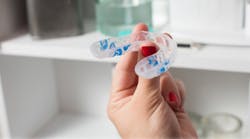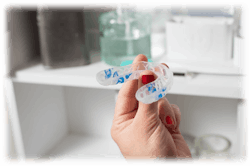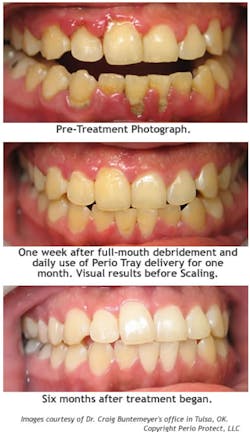Healthier gums are just 1 of the 3 things patients can get from hydrogen peroxide
Many patients dread going to their dental hygiene appointments because their gums bleed and hurt for a few days afterward. However, hydrogen peroxide provides a way to soften and decrease the deposits to make prophies easier for these patients.
A simple 10 to 15–minute daily application of low-concentration hydrogen peroxide via a comfortable prescription tray (e.g., the PerioProtect system) will help manage the bacteria on the teeth and below the gums. With regular use, the teeth will be cleaner and the gums healthier.
Improving gum health is just one important benefit of using hydrogen peroxide in a sealed tray. The peroxide improves breath and whitens teeth.
VSCs and bad breath
The cause of halitosis is like the cause for the foul air at a natural hot spring. If you have ever been to a natural hot spring, you know that while the hot water feels great, the smell in the air is unpleasant. That aroma is caused by sulfur created by bacteria—"bacteria deep down converts sulfur to the rotten egg gas smell of many hot springs.” (1)
The bacteria that cause bad breath live under the gums; their excretions are called volatile sulfur compounds (VSCs) and are similar to the sulfur compounds at a hot spring. (2) Most products on the market for treating bad breath do not get below the gumline. It’s the sulfur compounds secreted by the bacteria that cause bad breath. The best way to kill the bacteria is to deliver the antimicrobial, hydrogen peroxide, deep under the gums with a comfortable tray.
Whitening properties
Having whiter teeth is the norm these days, but whitening often causes sensitivity. Higher concentrations hydrogen peroxide whiten teeth faster, but create a greater sensitivity risk: “A chemical reaction occurs during teeth whitening, and it is thought that, during this process, the dentinal plugs within the tubules are released. These plugs have been formed in the dentinal tubules to decrease sensitivity. When released, there is fluid flow internally, which excites the pulpal tissue and causes sensitivity.” (3) Using lower concentrations of hydrogen peroxide is a good option for patients with sensitivity, and many patients using PerioProtect notice whiter teeth within five to six weeks.
The oral microbiome and gum health
Hydrogen peroxide is a chemical that is produced in our own lungs, livers, and white blood cells every day. Hydrogen peroxide is even present when infant saliva reacts with human breastmilk, leading scientists to theorize that it helps promote a healthy oral and gut microbiome in human infants. (4) We are not talking about your grandmothers’ brown bottle of hydrogen peroxide. Remember the cause of the problem is below the gumline. Rinsing simply gets the palate, tongue, and cheeks. It does not reach below the gumline.
Hydrogen peroxide used as it is in the PerioProtect system removes harmful bacteria and leaves behind an oxygen-rich environment that can be colonized by more beneficial bacteria, leading to greater health throughout the whole body. (5)
PerioProtect offers one treatment for all three problems. To learn more about this option for your patients, go to letstalkgumdisease.com/#noninvasive.
References
1. Why no sulfur smell at scenic hot springs? Scenic Hot Springs [blog]. http://scenichotsprings.blogspot.com/2007/11/why-no-sulphur-smell-at-scenic.html. Published November 6, 2007.
2. Ratcliff PA, Johnson PW. The relationship between oral malodor, gingivitis, and periodontitis. A review. J Periodontol. 1999 May;70(5):485-9. https://aap.onlinelibrary.wiley.com/doi/abs/10.1902/jop.1999.70.5.485.
3. Osuna T. The sensitivity complaint. RDH magazine website. https://www.rdhmag.com/articles/print/volume-33/issue-10/features/the-sensitivity-complaint.html. Published October 15, 2013.
4. Infants’ saliva may react with breast milk to modulate their microbiomes. American Microbiome Institute website. http://www.microbiomeinstitute.org/blog/2015/9/8/infants-saliva-may-react-with-breast-milk-to-modulate-their-microbiomes. Published September 8, 2015.
5. It’s all about the bubbles. PerioProtect website. https://www.perioprotect.com/its-all-about-the-bubbles/. Published December 22, 2018.


